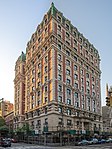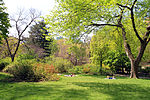The Langham
Central Park West Historic DistrictHistoric district contributing properties in ManhattanHistoric district contributing properties in New York CityManocherian familyNRHP infobox with nocat ... and 5 more
Residential buildings completed in 1907Residential buildings in ManhattanResidential buildings on the National Register of Historic Places in ManhattanSecond Empire architecture in New York CityUpper West Side

The Langham is a luxury apartment building located at 135 Central Park West on the Upper West Side of Manhattan, New York City. After the site was unused for more than 15 years, the building was constructed between 1905 and 1907. Built at a cost of US $2 million, the structure included modern amenities, such as ice accessible from every apartment. The building was designed in the French Second Empire style by architects Clinton and Russell. It was listed as a contributing property to the federal government designated Central Park West Historic District on November 9, 1982.
Excerpt from the Wikipedia article The Langham (License: CC BY-SA 3.0, Authors, Images).The Langham
Central Park Outer Loop, New York Manhattan
Geographical coordinates (GPS) Address Nearby Places Show on map
Geographical coordinates (GPS)
| Latitude | Longitude |
|---|---|
| N 40.777222222222 ° | E -73.975 ° |
Address
Central Park Outer Loop
Central Park Outer Loop
10023 New York, Manhattan
New York, United States
Open on Google Maps







